Do you spend a lot of time working in a command-line environment, editing and managing files using text editors? If so, then you know that having a good command over these tools can significantly increase your productivity and add value to your work. That’s where Vim comes in. If you’re new to Vim or just looking to brush up your skills, then come take a dive with me as we explore how Vim can benefit you and make your work more productive and enjoyable.
What is VIM
Vim is a powerful, free, and open-source text editor that is widely used by programmers, system administrators, and other professionals who work extensively in the command-line environment. Developed by Bram Moolenaar in the late 1980s, Vim is an enhanced version of the classic Unix text editor vi.. Vim offers a vast range of features and functionality, including support for multiple programming languages, extensive customization options, and a wide range of plugins and extensions. With Vim, you can edit text files quickly and easily, navigate your code with ease, and automate repetitive tasks using macros and scripting.
Vim – How it Helps
As someone who has worked in the industry and observed how professionals use text editors, I have come to realize that having a good command over VIM, even for basic file operations, can give individuals a significant advantage over their peers.
Many people use basic editors like Windows Notepad to edit files and transfer them to servers. Others use VIM as a basic editor without utilizing its various features, which defeats the purpose of using VIM altogether. The main reason behind this is that people do not invest the time required to learn the features and functionalities of VIM. However, the learning curve for basic VIM is not long. If you put in some effort in the beginning, and start utilizing the available features from the start, you will soon become accustomed to them.
Of course, there are many advanced editors available for advanced users, but in my opinion, for beginners, VIM is a must-tool to master as it offers several benefits, such as:
- Vim is widely available and portable, meaning you can use it on almost any platform or operating system.
- Vim offers advanced search and replace tools, easy navigation, and support for regular expressions, which can save you time and effort when working with large amounts of text.
- Vim is highly customizable, so you can tailor it to your specific needs and preferences.
These benefits make VIM an essential tool for anyone who wants to be efficient and productive while working with text files. Lets know take a look at basic vim operations
Starting with VIM
The Modes
VIM provides different modes to work with, and the editor behaves differently depending on which mode you are in.
As per vimhelp.org there are 7 basic modes, the commonly used ones are described below you can read more about the other modes here vimhelp.org
Normal Mode
In normal mode you can enter all the normal editor commands , this mode is often called command mode also.
Insert Mode
This mode allows users to do text editing.
Command Line Mode
In command line mode the user can enter a line of text (command) at the bottom of the window. This allows us to enter Ex commands by pressing “:”, Search and Replace Commands by pressing “/” or “?”, Filter Commands by pressing “!”
Visual Mode
Visual mode allows you to select the desired test or section of the text for editing or manipulation, It is useful when you want you commands to only work on a specific section or block of the document.
You enter visual mode by pressing “v” more on this later in the document.
When we first run the command vim <filename>, we start in the command mode. In this mode, if you press h or j or k or l, it will not insert those letter in the document, but you will be navigating left, down, up and to the right of you cursor, as your keyboard keys are mapped to commands.
Editing with VIM
on command line enter “vim <filename>” to open the file
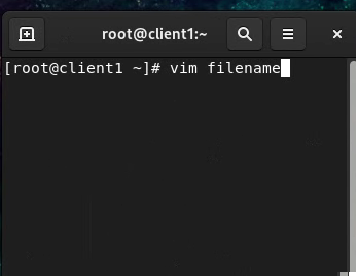
General syntax is vim [options] filename you can refer to vim documentation for better understating of options
press “i” to enter into insert mode
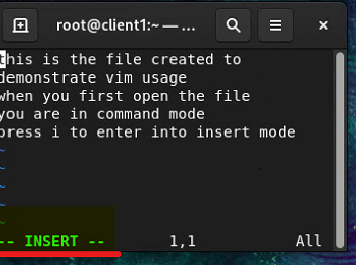
Tilde ("~") on any line means the line is empty of text.
To Save and Exit, press <ESC> followed by :wq!

Here pressing escape takes you back into command mode. Pressing colon makes you enter into execute mode
Options to enter insert mode
| Key . | Description |
|---|---|
| i | current cursor position |
| I | the beginning of the line |
| Key . | Description |
|---|---|
| a | after cursor position |
| A | at the end of Line |
| Key . | Description |
|---|---|
| o | below the cursor position |
| O | above the cursor position |
Taking help from within VIM
:help
In the command mode enter :help to view the help menu, you can also enter :help <topic> to get help with any specific command. All documentation can be viewed by entering : help syntax.txt
vimtutor
vim by default installs with a tutorial system called vimtutor, it can help you learn the basic vim functionality hands-on, you can start the vimtutor by running it from your command line
[deb123@midas24 ~]$ vimtutorSome ways to recover from error / incorrect inputs
Escaping out of trouble
When you first start with VIM, it is always possible to get confused, by typing wrong command, or entering the wrong mode. At all the time, you can press <ESC> key to get back to the normal mode, You may need to press it twice at times.
Undo the edits
In case you have made incorrect edits / changes to your file, you can press <ESC> to enter in the normal mode and then press “u” to undo the last change, you can press “u” multiple times to continue to undue previous edits. Once you are satisfied, you can save the file with :w so you are in the acceptable state.
Quit the file without changes
Similarly if you are unsure of changes done, but you dont want to risk it further, you can always exit the file without saving it, you can press <ESC> followed by :q! to quit the file forcefully without saving it. You can open it again to start editing as you may need.
Lets explore further
Navigation – Moving around your file
In command mode your keyboard keys are mapped to various navigation commands which enable you to move around your document with ease and efficiency.
The list is not exhaustive you can refer to vim help or documentation, there are several cheatsheets also available.
| Key | Description |
|---|---|
| h | move to the left of cursor |
| j | move down one line |
| k | move up one line |
| l | move to the right of the cursor |
| ^ | move to the beginning of the line |
| $ | move to the end of the line |
| gg | move to the first line of the document |
| G | move to the end of the document |
| 55gg | move to line number 55 |
| 0 (zero) | Start of line |
Manipulating your text in normal mode
Deleting
| Key | Description |
|---|---|
| x / X | delete char under the cursor / delete to the left of the cursor |
| s / S | change one character / change whole line |
| dw | delete word |
| D | delete to end of line |
| d<motion> | deletes in the direction of the motion |
| J | Deleting a line break |
| cw | delete word and insert (change word) |
| C | deletes line and insert |
To delete 7 characters from the beginning of the line, scroll to the line, you can press 0 to go to the beginning, Press x 7 times
Cut / Copy and Paste Operations
| Key | Description |
|---|---|
| dd | delete the current cursor line. |
| yy | Copy line from current cursor position. |
| x | Delete single character / works like delete button |
| X | Works like Backspace button |
| p | Paste copied line below the cursor. |
| P | Paste copied line above the cursor. |
Moving your text
Take your cursor to the word or line you want copy and paste or cut and paste
This is first line
This is line 3 enter <dd>
This is line 2
Enter dd to delete the line, navigate to the new position and enter p
This is first line
This is line 2 enter <p>
End State
.This is first line
This is line 2
This is line 3
Repeating Commands
Repeating a command using a count
For all the commands executed in normal mode vim supports command repetition, where instead of entering the same command multiple times to repeat the desired action we can prefix the same with the number of repetitions, so to delete 5 lines – 5dd : open the file –> enter 4gg to go to line 4 –> enter 5dd to delete lines from 4 to 8
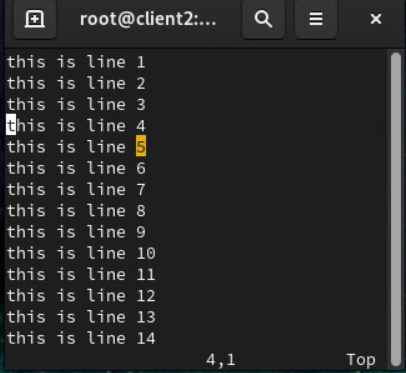
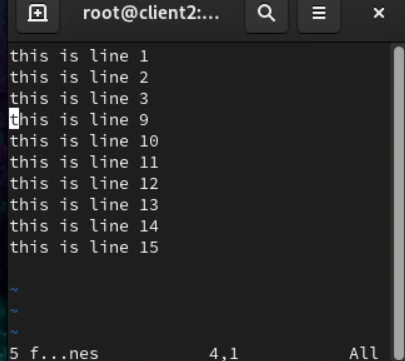
to move up 9 lines – 9k
to copy 5 lines – 5yy
Repeating a change or set of changes
The “.” is a very powerful command in vim, it repeats the change (or all the changes since last edit), it is super useful when you have to the same changes in different sections of the document,
For example you want to
Note : The “.” command will not work for the “u” (undo), Ctrl-R (redo) and commands that start with a colon (:).
Visual Mode
As mentioned visual mode helps to identify the area of text that needs to be modified visually, it is helpful when it is not easy to decide the area of text by say line numbers
Start Visual Mode
You start visual mode by pressing v in the normal mode and then use navigation to select the text h, j, k, l or arrow keys
vlllllllll
Selecting lines : If you want to select who lines you should start visual mode with V and can then select more lines with j or k
Vjjjjj

Selecting blocks
When you are working with text arranged on rows and columns and you want to an operation on columns or group of columns you can do so by starting visual mode using <Ctrl + v>
Take your cursor to the column you want to select enter <Ctrl + v>ll
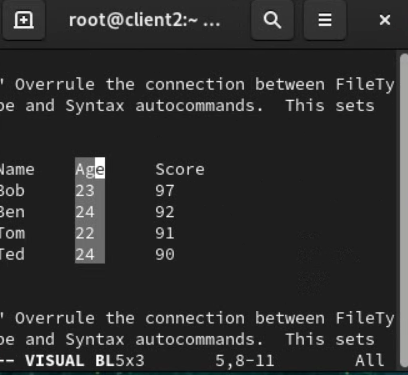
Moving to the other end of the Selection
Once you have select the a block or section of the text you may need to make changes to the other side for the selection pressing “o” or “O” can help you move from one side to the other side
Operations
Once you have made you selection you can make any changes to the selected text using commands,
In block selection mode you can remove / copy paste / cut paste data column wise
You can also do search and replace operations on the selected text as described in the following section
| Change | Action |
|---|---|
| for deleting | press d |
| for cut paste | take your cursor to the new position and press p |
| for copying | y |
| for copy and paste | take your cursor to the new position and press p |
Search and Replace Operations
Vim provides highly effective ways to search as well as search and replace. With the use of regular expressions, and the control of where and which places to search and replace, these commands can make you a power user
Vim Simple Search
To search for a string in Vim, use the forward slash command followed by the string.
/file
Press Enter to jump to the first occurrence of the string.
To jump to the next occurrence of a string in Vim, simply press the “n” key. You can repeat this command to continue searching for the next occurrence of the same string.
If you want to search for occurrences backwards in Vim, you can use the “N” key. Pressing “N” will take you to the previous occurrence of the string you are searching for.
To search for a string from the bottom to the top of a file in Vim, you can use the question mark command followed by the string you want to search for.
?file
Once you press Enter, Vim will jump your cursor to the next occurrence of the string above your current cursor position. In this case “n” will jump to the occurrence above and “N” will reverse search for next occurrence below the current cursor position.
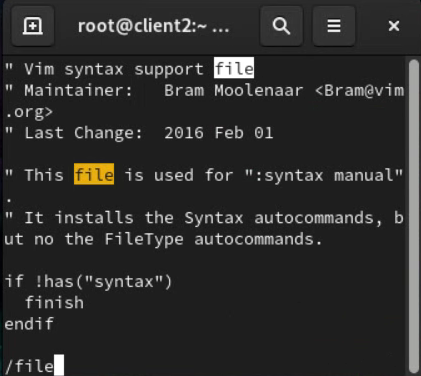
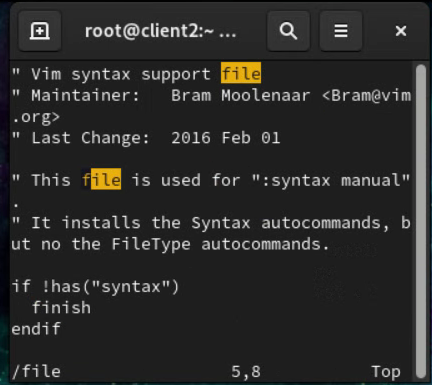
And Replace
To search and replace once we are at the occurrence which we want to change we can simply press “cgn” followed by the new string
Here “cgn“ changes the next match of the search pattern,
As shown, we have first used n to move the second occurrence of the string “file”, and then entered cgn, vim automatically deletes the string file and enters insert mode,
Here we enter FILES
You can repeat the same for following occurrence by pressing <ESC> followed by n and “.” dot (refer to section : Repeating a change or set of changes above)
Once done you can save and exit the file.
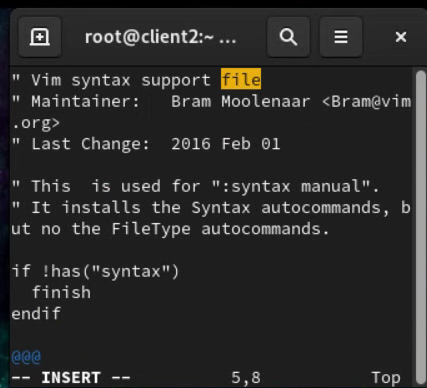
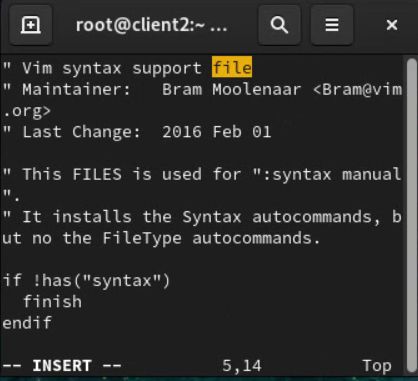
Using the substitute Command
Vim Substitute command makes search and replace operations very easy, the basic syntax in normal mode is
:s/<oldstring>/<newstring>
this will replace the first occurrence of the oldstring on the line where your cursor is present.
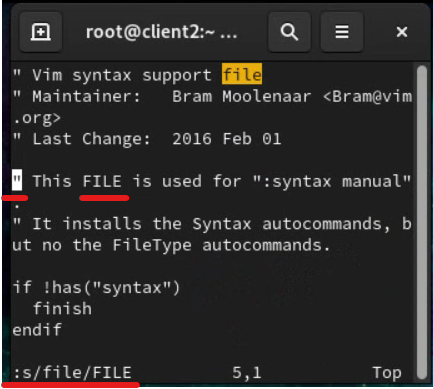
Variations
| Options | syntax | Descripition |
|---|---|---|
| replacing all the occurrence in a single line | :s/<search_term>/<replace_term>/g | replace all the occurrences of the oldstring on the line |
| replacing all the occurrences in the entire file | :%s/<search_term>/<replace_term>/g | replace all the occurrences across the entire document |
| replacing all the occurrences in the specific lines | :1,5s/<search_term>/<replace_term>/g | replace all the occurrences between the lines 1 and 5, the sysntax is :start_line_number, end_line_number s/<search_term>/<replace_term>/g |
| search case insensitive | :s/<search_term>/<replace_term>/gi | adding “i” make the search case insensitive |
| search and replace with confirmation | :%<search_term>/<replace_term>/gc | adding “c” will prompt you for confirmation before replacing for every occurrence |
| search for the whole word | :%\<search_term\>/<replace_term>/gc | adding <> around the word only matches the whole word and not when the string is a part of larger word, here backslash is used as n escape character |
Comment lines (add # before the line) from 5 to 10: | :5,10s/^/#/ | Here ^ (caret symbol, <SHIFT>+6) represents the beginning of the line, so this replaces the beginning of the line with #, |
Uncomment lines (remove # before the line) from 10 to 15: | :10,15s/^#// | Here we search for # at the beginning of the line (^) and replace it with blank, uncommenting the line |
Using regular expression
Regular expressions, also known as regex or regexp, are a pattern-matching system used to search for and manipulate text based on certain rules or patterns. Regular expressions can be used in Vim’s substitute command to replace all occurrences of a pattern in a file, By using regular expressions, you can perform complex search and replace operations that are difficult or impossible to achieve with simple string matching. Here we look at some common regex examples, refer here for detailed regex usage
| remove all blank line | :%s/^$//g | Here ^ matches the beginning and $ matches the end of the line, so it will match any line were there is nothing between beginning and end = blank line and replace it with nothing, hence removing it |
| Replace all digits with “x”: | :%s/\d/x/g | Here \d matches all the digits |
| Replace all words starting with “a” and ending with “e” with “replacement”: | :%s/a\w*e/replacement/g | here \w matches any word character (alphabets, digits, underscore) If we only had to match words with text we could have used \a |
| Insert a new line after every occurrence of a semicolon: | :%s/;/;\r/g | Here we are replacing ; with ; followed by \r \r is the new line Eg. you have a list of statements separated by semicolons and you want to split them into individual lines |
| remove trailing whitespace characters across all lines in the file | :%s/\s\+$//g | Here \s matches match space and tab characters, \+ match one or more times, |
| replace digits in a pattern with X (hide them for security purposes) | :%s/\d{3}-\d{2}-\d{4}/XXX-XX-XXXX/g | Here \d matches digits {3} matches three occurrences for digit and so on for each block, so only those patterns will be impacted where we have 3digits-2digits-4digits |
| To match multiple words and replace them with a single word: | :%s/\(word1\|word2\|word3\)/replacement_word/g | Here \ is the escape character, so substitute command consider ( and | as a special character, and | provides OR functionality |
| To find and fix formatting errors in a list of email addresses: | :%s/\(\w\+\) *@ *\(.\+\)/\1@\2/g | Here \(\w\+\) matches one or more word characters (letters, digits, or underscores) and saves the match as a “capture group” for later use. The parentheses around \w\+ create the capture group.*@ * matches zero or more spaces (including none) around the “@” symbol and any number of spaces after it.\1 backreference to the first capture group\2 backreference to the second capture group |
Working with Multiple Files
Vim allows you to work with multiple files in several ways
Opening multiple files
To open multiple files in Vim, simply append all filenames as command line arguments like this:
vim /path/to/file1 /path/to/file2 /path/to/file3
Once Vim is opened, the first file will be displayed. You can navigate between the files using these Vim commands:
:n(ext) # jumps to the next file
:prev # jumps to the previous file
However, it might be difficult to keep track of which files are open, VIM provides another way to open the files in different tabs
Opening multiple files in tabs
Vim has tabs support since version 7.0, making it easy to work with multiple files.
To open multiple files in separate tabs, use the -p CLI flag followed by the filenames:
vim -p /path/to/file1 /path/to/file2 /path/to/file3This opens Vim with all files opened in tabs, and the tab bar is displayed on top of the editor window.
To open a new tab while already in Vim’s normal mode, use the command
:tabe [/path/to/file]You can then switch between tabs using
:gtOR:tabn[ext]to jump to the next tab,- :
gTor:tabp[revious]to jump to the previous tab,
or n followed by gt to jump to a specific tab (where n is the tab index starting at 1).
To close the current tab, use :tabc[lose] command-line command.
Tabs make it easier to manage multiple files in Vim, but you may want to compare the files and edit them in the same window, vim provides several options for that as well
Comparing and editing files side by side
To view multiple files in a single Vim workspace, you can use the built-in split feature. In Vim, you can split the window either horizontally or vertically by using the following command-line commands:
:sp[lit] [/path/to/file]# splits the window horizontally [and opens the file]:vs[plit] [/path/to/file]# splits the window vertically [and opens the file]
After splitting the window, you’ll have multiple windows open in Vim. You can navigate between the windows and perform various actions by using the following commands or keystrokes while in normal mode:
- Jumping between windows is
Ctrl-w <cursor keys>,Ctrl-w [hjkl], orCtrl-w Ctrl-[hjkl] - Jumping to the next window is
Ctrl-w worCtrl-w Ctrl-w - Jumping to the previous window is
Ctrl-w W - Jumping to the last accessed window is
Ctrl-w porCtrl-w Ctrl-p - Closing the current window is
Ctrl-w c or :clo[se]Making the current window the only one and closing all other windows is Ctrl-w o or :on[ly]
Command Line Mode – Summary
Esc: Press key to change the mode to Execute mode.
:q : Quit file.
:w : Write changes to file.
:wq : Save & Quit.
:x : Save & Quit.
:q! : Quit forcefully
:wq! : Save & Exit forcefully.
:| : Go to first line of the file.
:set nu: Set the numbers to line.
:set nonu: Remove numbers from lines.
:<Specific Line Number>: Specified Line Number.
:r /root/test : Copy the content of test file in cursor current position.
:r !date : The command output will paste in current cursor position.
:!ls - Execute shell command "ls"Lets look Deeper
Configuring your VIM
VIM can be configured using .vimrc file which for Centos / RHEL the system wide configuration file for Vim is /etc/vimrc., where it is at /etc/vim/vimrc.local file on Ubuntu/Debian based operating system
You can directly edit the above files to make necessary configuration changes for vim, but then those will be applicable at system level, for user level you can create a .vimrc file for your login user with the following command:
$ touch ~/.vimrcThen, open .vimrc file with vim with the following command:
$ vim ~/.vimrcHere you can define your keybindings, set themes, install plugins etc.
Showing Line Numbers
if you want to show the line number by default every time you open the file using vim you can simply add the entry “set nu” in the file, now every time you will open any file using vim, the line numbers will be there by default
You can explore more such option here
Configure Simple Mapping
A mapping maps a key stroke to a set of vim commands, if you use a set of key commands often, then it is a good idea to create a mapping for the same, this will help you complete you task faster
Map x to dd
Normally x deletes a single chracter if we make the following entry in ~/.vimrc file, when you press x it will delete the line instead
:map x ddMap a key to set of commands
If you want to add curly brackets around a word say “customername”. You can make the following entry
:map <F3> i{<Esc>ea}<Esc>here map maps “<F3>” with a set of commands – “i” enter into insert mode, enter { , <ESC> to enter normal mode, “e” to reach end of the word, “a” to append (insert mode), and enter }.
Once set the entire operation of changing customername to {customername} can be achieved with single key click on F3
Configuring Plugins
Vim offers a way to enhance its functionality by utilizing “plugins”. There are primarily two methods to install Vim plugins.
- The first and easiest method is by using a plugin manager. This can be likened to a package manager, but for Vim.
- The second method is by manually cloning repositories in specific directories.
Manually installing plugins is not recommended as it can become confusing and complicated when dealing with a large number of plugins. Additionally, there is a risk of mistakenly cloning the plugin in the wrong directory, which can potentially cause issues with your Vim plugins.
You can refer to How to Extend Vim’s Functionality by Adding Plugins to understand more about adding plugins.
Conclusion
In conclusion, Vim is a powerful and versatile text editor that can significantly enhance your productivity once you become familiar with its features and capabilities. It offers several advantages over other text editors, such as its speed, efficiency, and extensibility through the use of plugins. Vim’s modal editing and command-line interface may require some time to get used to, but once you do, you can work with unprecedented speed and accuracy. With this guide, you should be equipped with the knowledge necessary to start using Vim effectively and efficiently for all your text editing needs.
.
.
Nikhil Kumar Ahluwalia
Founder Upspir
Nikhil has more than 16 years of industry experience. Prior to founding Upspir, he served as the Vice President of Support, Services, and Delivery at Ameyo/Exotel, where he gained extensive experience in managing and leading technical support and delivery teams. With Upspir, Nikhil aims to take his passion for developing and mentoring people to the next level by sharing his experiences and knowledge with those who want to build their careers in the tech support domain.


